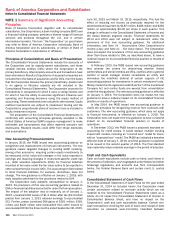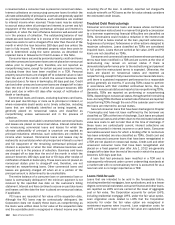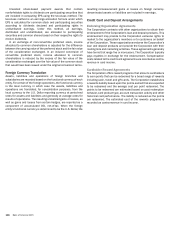Bank of America 2015 Annual Report Download - page 139
Download and view the complete annual report
Please find page 139 of the 2015 Bank of America annual report below. You can navigate through the pages in the report by either clicking on the pages listed below, or by using the keyword search tool below to find specific information within the annual report.Bank of America 2015 137
operating activities and investing activities. The corrections
resulted in a $3.4 billion increase in net cash provided by operating
activities, offset by a $3.4 billion increase in net cash used in
investing activities when compared to the Consolidated Statement
of Cash Flows in the Form 10-K for the year ended December 31,
2014.
The Consolidated Statement of Cash Flows included in the
previously-filed Form 10-Qs for the quarterly periods ended March
31, 2015 and June 30, 2015 also incorrectly reported this type
of non-cash activity by $4.8 billion and $9.3 billion, where an
increase in net cash provided by operating activities was offset by
an increase in net cash used in investing activities. The incorrectly
reported amounts in these 2015 quarterly periods also were not
material to the Consolidated Financial Statements taken as a
whole, did not impact the Consolidated Statements of Income or
Consolidated Balance Sheets and had no impact on cash and cash
equivalents for those periods.
For information on certain non-cash transactions, which are
not reflected in the Consolidated Statement of Cash Flows, see
Note 4 – Outstanding Loans and Leases and Note 6 – Securitizations
and Other Variable Interest Entities.
Securities Financing Agreements
The Corporation enters into securities borrowed or purchased
under agreements to resell and securities loaned or sold under
agreements to repurchase (securities financing agreements) to
accommodate customers (also referred to as “matched-book
transactions”), obtain securities to cover short positions, and to
finance inventory positions. Securities financing agreements are
treated as collateralized financing transactions except in instances
where the transaction is required to be accounted for as individual
sale and purchase transactions. Generally, these agreements are
recorded at the amounts at which the securities were acquired or
sold plus accrued interest, except for certain securities financing
agreements that the Corporation accounts for under the fair value
option. Changes in the fair value of securities financing
agreements that are accounted for under the fair value option are
recorded in trading account profits in the Consolidated Statement
of Income.
The Corporation’s policy is to obtain possession of collateral
with a market value equal to or in excess of the principal amount
loaned under resale agreements. To ensure that the market value
of the underlying collateral remains sufficient, collateral is
generally valued daily and the Corporation may require
counterparties to deposit additional collateral or may return
collateral pledged when appropriate. Securities financing
agreements give rise to negligible credit risk as a result of these
collateral provisions and, accordingly, no allowance for loan losses
is considered necessary.
In transactions where the Corporation acts as the lender in a
securities lending agreement and receives securities that can be
pledged or sold as collateral, it recognizes an asset on the
Consolidated Balance Sheet at fair value, representing the
securities received, and a liability, representing the obligation to
return those securities.
Collateral
The Corporation accepts securities as collateral that it is permitted
by contract or custom to sell or repledge. At December 31, 2015
and 2014, the fair value of this collateral was $458.9 billion and
$508.7 billion, of which $383.5 billion and $419.3 billion was
sold or repledged. The primary source of this collateral is securities
borrowed or purchased under agreements to resell.
The Corporation also pledges company-owned securities and
loans as collateral in transactions that include repurchase
agreements, securities loaned, public and trust deposits, U.S.
Treasury tax and loan notes, and short-term borrowings. This
collateral, which in some cases can be sold or repledged by the
counterparties to the transactions, is parenthetically disclosed on
the Consolidated Balance Sheet.
In certain cases, the Corporation has transferred assets to
consolidated VIEs where those restricted assets serve as
collateral for the interests issued by the VIEs. These assets are
included on the Consolidated Balance Sheet in Assets of
Consolidated VIEs.
In addition, the Corporation obtains collateral in connection
with its derivative contracts. Required collateral levels vary
depending on the credit risk rating and the type of counterparty.
Generally, the Corporation accepts collateral in the form of cash,
U.S. Treasury securities and other marketable securities. Based
on provisions contained in master netting agreements, the
Corporation nets cash collateral received against derivative
assets. The Corporation also pledges collateral on its own
derivative positions which can be applied against derivative
liabilities.
Trading Instruments
Financial instruments utilized in trading activities are carried at
fair value. Fair value is generally based on quoted market prices
or quoted market prices for similar assets and liabilities. If these
market prices are not available, fair values are estimated based
on dealer quotes, pricing models, discounted cash flow
methodologies, or similar techniques where the determination of
fair value may require significant management judgment or
estimation. Realized gains and losses are recorded on a trade-
date basis. Realized and unrealized gains and losses are
recognized in trading account profits.
Derivatives and Hedging Activities
Derivatives are entered into on behalf of customers, for trading or
to support risk management activities. Derivatives used in risk
management activities include derivatives that are both
designated in qualifying accounting hedge relationships and
derivatives used to hedge market risks in relationships that are
not designated in qualifying accounting hedge relationships
(referred to as other risk management activities). Derivatives
utilized by the Corporation include swaps, financial futures and
forward settlement contracts, and option contracts.
























